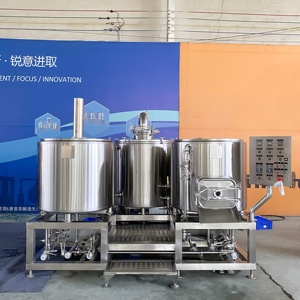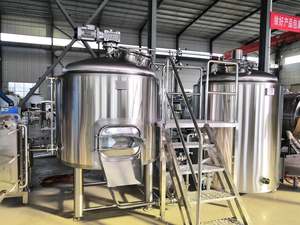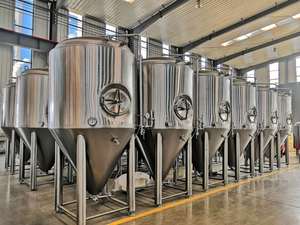
All categories
Featured selections
Trade Assurance
Buyer Central
Help Center
Get the app
Become a supplier

(12786 products available)




















Market Overview: The global beer brewing systems market is experiencing notable growth, fueled by an increasing demand for craft beer and home brewing. According to Research and Markets, the beverage processing equipment market, which includes beer brewing systems, is projected to grow from $26.81 billion in 2023 to $28.40 billion in 2024, with a robust CAGR of 6.19% expected to reach $40.85 billion by 2030. This surge is attributed to shifting consumer preferences towards craft and specialty beers, as well as the growing popularity of home brewing. The craft beer segment has particularly benefited from the trend towards unique flavor profiles and local sourcing, which encourages breweries to invest in advanced brewing systems for enhanced production capabilities.
Regional Insights: The demand for beer brewing systems is notably strong in regions with established beer cultures, such as North America and Europe. In the U.S., the craft beer movement has led to increased investments in brewing technologies, with many small and medium-sized breweries seeking efficient, multifunctional systems to meet diverse consumer demands. Meanwhile, the Asia-Pacific region, driven by rising disposable incomes and changing lifestyles, is witnessing a rapid increase in both craft breweries and home brewing enthusiasts. The integration of smart technologies in brewing systems is also on the rise, enhancing operational efficiency and product consistency, as manufacturers adapt to the market's evolving landscape. This trend indicates a promising future for beer brewing systems as they align with consumer preferences for quality and innovation.
A beer brewing system refers to a complete set of machinery used for brewing beer. Different scales often accompany various features, such as the residential/around-home-scale brewing systems for homebrewers to commercial brewing systems typically found in the larger-scale food and beverage industry. Below is a shortlist of the most standard beer brewing systems, along with a concise description of the feature or scale of the system.
In addition to the above, there are also some custom brewery systems available for clients to choose from. If businesses are looking to get a unique brewery system for their brand or business, they could get in touch with a supplier to find one that suits their needs better.
The key specifications and typical maintenance requirements of a commercial-grade beer brewing system are as follows:
Capacity:
Beer brewing systems are usually available in different capacities to meet specific commercial needs. Typical system sizes include 200-liter, 300-liter, 500-liter, 1000-liter, and 2000-liter, among others. Businesses usually select an appropriate system capacity based on indicators such as the demand for specific beer varieties, the volume of sales, tight brewing schedules, and so on.
Main equipment:
A typical beer brewing system consists of several main pieces of equipment, each of which requires proper care and maintenance. These include:
Mash Tun:
The Mash Tun should be rinsed out and cleaned after each brewing session. Any residual grains or yeast should be scrubbed off. A non-caustic cleanser should be used to remove any residual proteins or oils. The tun should be sanitized, and a thin layer of food-grade mineral oil should be applied to prevent oxidation.
Boil Kettle:
like the Mash Tun, the Boil Kettle should be cleaned immediately after use. The water temperature should be above 60°C to burn off carbon residues. Once the exterior is scrubbed clean, non-abrasive cleaners should be used on the interior. The kettle should be descaled occasionally to prevent mineral buildups.
Fermentation Vessels:
These are perhaps the most essential pieces of equipment in a beer brewing company. After the Fermenter is emptied, the waste products should be scraped off. Then, the entire Fermenter should be sanitised using a caustic solution and cleaned thoroughly with warm water.
Filters and pumps:
These should be inspected regularly, and any undue abrasion or damages should be addressed. They should be cleaned after every use, and brewers should develop a standardised procedure to ensure proper maintenance. The filters are usually replaced or cleaned.
Heat exchangers:
These should be descaled periodically to prevent buildups. The exchangers should be cleaned carefully with dedicated cleaning solutions. Any damages to the plates or membranes should be replaced and repaired immediately to ensure optimal performance.
NOTE: In addition to the equipment mentioned above, a typical beer brewing system includes several auxiliary machines, such as a control panel, conditioning tank, carbonation equipment, bottling and packaging machines, etc. These systems should also be maintained according to the manufacturers' instructions to ensure smooth operations.
A beer brewing system is used to produce different kinds of beer in industries and commercial settings. It is helpful in the following scenarios:
When looking for the right beer brewing equipment, business buyers need to research the suppliers and their brewing systems thoroughly. First, they should begin by assessing their brewing capacity requirements. They must evaluate their production goals and the amount of beer they intend to brew per batch to determine the optimal system size.
Second, buyers should consider the levels of automation they are looking for. Do they want a brewing system that they will have to do most of the processes manually? Or do they want a system with fully automated process control for greater precision and efficiency? Third, buyers will have to look at the available space. They must evaluate the floor space they have for brewing, storage, and other related activities to determine the ideal system dimensions.
Business buyers should also consider the beer brewing system's energy efficiency. Buyers should look for systems designed to minimize energy consumption and reduce operational costs. More importantly, buyers should evaluate the system's compatibility with their existing supply chains. For example, a buyer who brews beer with specific ingredients will need a brewing system that can accommodate those components.
Of course, business buyers should also consider their budget constraints. They should explore a variety of brewing system options within their budget and consider the long-term return on investment.
Buyers will want to invest in a brewing system with high-performance and durable components to ensure smooth operation and minimal downtime. Finally, buyers should also consider any additional features the brewing system comes with, such as cleaning systems, safety mechanisms, recipe storage, and customizability options.
Q1: How big is the global beer brewing system market?
A1: The global beer brewing system market size was valued at USD 838.7 million in 2022 and is poised to grow at a significant CAGR of 7.6% during the forecast period 2023-2030.
Q2: What are the trends in the beer brewing system market?
A2: The market for beer brewing systems is being driven by the growing demand for craft beer across the globe in a wide range of industrial end-user applications. In addition, the increasing popularity of alcoholic beverages is another factor propelling the global market growth.
Q3: Which regions are contributing to the market growth?
A3: North America dominated the brewing system market in 2022. The region is home to a large number of small and independent craft brewers driving the demand for beer brewing systems. Europe is also a significant market for beer brewing systems.